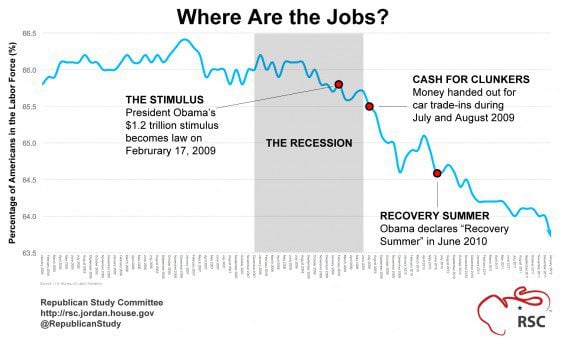A Tale of Two Charts: Bush Tax Cuts Created Jobs – Unlike Obama’s Spend Your Way to Hell Plan
Posted by Jim Hoft on Monday, July 23, 2012, 6:12 AM
A Tale of Two Charts–The Bush tax cuts created jobs.

The Bush tax cuts in 2003 created 8.1 million jobs. (Investors)
Investor’s reported:
From June 2003 to December 2007, the economy added 8.1 million jobs, according to the Bureau of Labor Statistics. The unemployment rate fell to 5% from 6.3%. Real GDP growth averaged close to 3% in the four-plus years after that, and the budget deficit fell steadily from 2004 to 2007.Unfortunately for America, Barack Obama’s ‘Spend your way to hell’ plan did not have similar results.
And despite Obama’s claim, Bush’s policies did not increase income inequality. In fact, inequality was the same when Bush left office as when he came in.

Since the trillion dollar Obama-Pelosi stimulus was passed the labor force participation rate has dropped to a 29 year low. (RSC)
Since Obama took office the labor force has shrunk from 66% to 63% as almost 5 million American adults stopped looking for work.
The Republican Study Committee reported:
Democrats said their costly plan ($1.2 trillion, including interest) would “save or create” up to 4 million jobs and bring the unemployment rate down to about 6% today. The unemployment rate has not fallen below 8% at any point in the last 36 months. Furthermore, the official unemployment rate does not actually count unemployed people who have given up looking for work.Here’s another way to look at it…
The above chart shows the “labor force participation rate.” This statistic represents the share of working-age Americans who are either employed or unemployed but looking for work. It is not a pretty picture. Only 63.7% of working-age Americans are currently in the workforce – the lowest in almost 29 years!


No comments:
Post a Comment